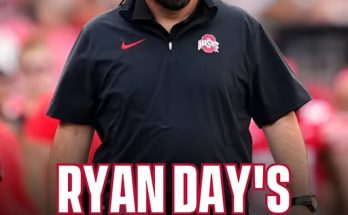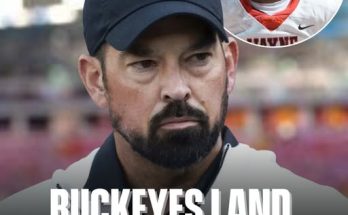In a college football landscape increasingly dominated by massive NIL (Name, Image, and Likeness) deals, one athlete’s decision has sent shockwaves across the sports world. Ohio State’s star wide receiver Lincoln Kienholz has stunned fans, analysts, and insiders alike by turning down a jaw-dropping $6.5 million NIL offer from the University of Southern California (USC), opting instead to remain loyal to the Buckeyes. This choice shines as a beacon of team loyalty and integrity in an era where financial incentives often drive athlete decisions more than anything else.
The NIL era has changed college sports forever. Since the NCAA’s historic policy change allowing student-athletes to profit from their name, image, and likeness, the landscape has transformed into a marketplace of opportunity for elite talent. Major programs and their boosters compete fiercely to secure commitment and retention of top-tier players by dangling lucrative endorsement deals, sponsorships, and partnerships. It’s not uncommon now for the nation’s best recruits to receive multi-million-dollar NIL offers that can rival or exceed early professional salaries.
Yet amid this frenzy of financial incentives and brand-building, Lincoln Kienholz’s decision stands out as profoundly rare and almost unheard of. USC, a program with a storied football tradition and massive NIL backing, reportedly offered Kienholz a $6.5 million NIL package to transfer to their school. This offer would place him among the highest-paid college athletes in NIL history and would provide not only unparalleled financial security but also major national exposure in the Los Angeles market. However, Kienholz declined the offer outright, expressing a deep commitment to Ohio State and the Buckeyes’ program.
This choice is remarkable on multiple levels. For one, the magnitude of the offer itself is historic. Few players in the college football landscape receive NIL deals of such scale, and it reflects USC’s aggressive efforts to leverage NIL as a recruiting tool. Kienholz’s outright rejection signals a refusal to let money be the sole factor guiding his career path, instead prioritizing values that transcend financial reward. In an age when player movement is often dictated by dollar signs, this marks a bold and principled stance.
For Ohio State, this decision is an enormous win. The Buckeyes have long been a powerhouse in college football, consistently recruiting elite talent and competing for national championships. However, NIL introduced a new wrinkle in player retention, as athletes now weigh financial offers from other schools alongside traditional factors such as playing time, coaching, and academic opportunities. Kienholz’s choice to remain loyal despite a lucrative offer elsewhere is a testament to the culture Ohio State has cultivated—a culture built on trust, camaraderie, and a commitment to team success.
Moreover, Kienholz’s decision sends a powerful message to other athletes navigating the NIL era. The temptation of massive NIL contracts can sometimes overshadow the importance of fit, relationships, and long-term development. But by placing team loyalty and personal integrity above financial gain, Kienholz is setting a standard for how athletes might approach these complex decisions. It challenges the notion that NIL deals must dictate career moves and reminds the sports world that values like loyalty, passion, and dedication remain just as vital as ever.
From Kienholz’s perspective, the decision wasn’t easy. As a highly talented wide receiver, he undoubtedly understands the financial opportunities at stake. The $6.5 million offer from USC represented a life-changing sum, one that could have provided immediate financial security for him and his family. But Kienholz reportedly felt a deep connection to Ohio State—his coaches, teammates, and fanbase—and believed that remaining with the Buckeyes was the right choice for his development both on and off the field.
This kind of commitment reflects maturity and foresight, qualities that set Kienholz apart as a leader. While the financial incentives were tempting, he recognized the value of continuity, coaching stability, and competing for championships at Ohio State. He also likely factored in his long-term goals, including aspirations for an NFL career. Staying with a program that believes in him, supports his growth, and offers top-level competition can be more valuable in the long run than chasing immediate financial gain.
The Buckeyes’ coaching staff also played a critical role in this outcome. They have fostered an environment that emphasizes player development, team unity, and personal growth, which helped reinforce Kienholz’s desire to stay. Coaches have been transparent and supportive regarding NIL opportunities, helping players navigate this new landscape while maintaining focus on football and academics. This balanced approach has resonated with Kienholz and contributed to his decision to remain loyal.
The impact of this decision will extend beyond just Kienholz and Ohio State. It may inspire other athletes to reconsider their priorities and encourage programs to strengthen their cultures and player relationships. In an era where NIL deals can sometimes feel like bidding wars, the human element—the bonds between players, coaches, and communities—remains essential. Kienholz’s rejection of a record NIL offer is a reminder that loyalty and character still hold immense power.
Critics might argue that athletes should take full advantage of NIL deals, especially since their college careers are brief and professional opportunities are not guaranteed. Indeed, many players rely on NIL earnings to support themselves and their families. But Kienholz’s choice highlights that there’s more than one way to approach the NIL era. For some, prioritizing personal fit, team goals, and long-term growth can outweigh immediate financial incentives.
This decision also highlights the evolving role of NIL in college sports. It’s not simply about the size of the deal but how NIL integrates with an athlete’s overall experience. Programs that create authentic environments where players feel valued and supported may find it easier to retain top talent, even in the face of lucrative external offers. Kienholz’s choice may encourage schools to invest more in building strong cultures, transparent communication, and holistic player development.
Furthermore, the public reaction to Kienholz’s decision has been overwhelmingly positive. Fans, analysts, and former players have praised his integrity and loyalty. Many see it as a refreshing departure from the transactional nature often associated with NIL and transfers. Social media buzzed with admiration for Kienholz’s character, highlighting him as a role model for aspiring athletes everywhere.
In addition to the immediate financial implications, Kienholz’s choice also preserves his marketability and legacy at Ohio State. Being a standout athlete who prioritizes team loyalty could enhance his personal brand in ways that extend beyond NIL money. Sponsors and partners increasingly value authenticity and character, traits Kienholz has demonstrated in abundance. This could open up diverse endorsement opportunities that align with his values and long-term vision.
Looking ahead, Kienholz’s decision may influence the broader college football transfer and recruitment landscape. Schools that rely heavily on NIL to lure players might find that money alone is insufficient to secure loyalty. Instead, the emphasis may shift toward building strong, supportive environments that attract and retain talent through shared purpose and genuine connection. This could lead to a more balanced, sustainable approach to athlete recruitment in the NIL era.
Ultimately, Lincoln Kienholz’s rejection of a $6.5 million NIL offer from USC to stay loyal to Ohio State is more than just a financial decision. It’s a statement about identity, values, and the true meaning of commitment in college sports. In a time when NIL deals dominate headlines and player movement, Kienholz reminds us that loyalty and integrity still matter—and that sometimes, the greatest reward isn’t the money, but the pride in wearing your school’s colors and competing for something bigger than yourself.
As the NIL era continues to evolve, stories like Kienholz’s will serve as important touchstones. They illustrate that athletes can successfully navigate these new opportunities while holding fast to the principles that made college sports so special in the first place. For Lincoln Kienholz and Ohio State, this moment will be remembered not just for the money turned down, but for the loyalty shown and the example set for future generations of student-athletes.



